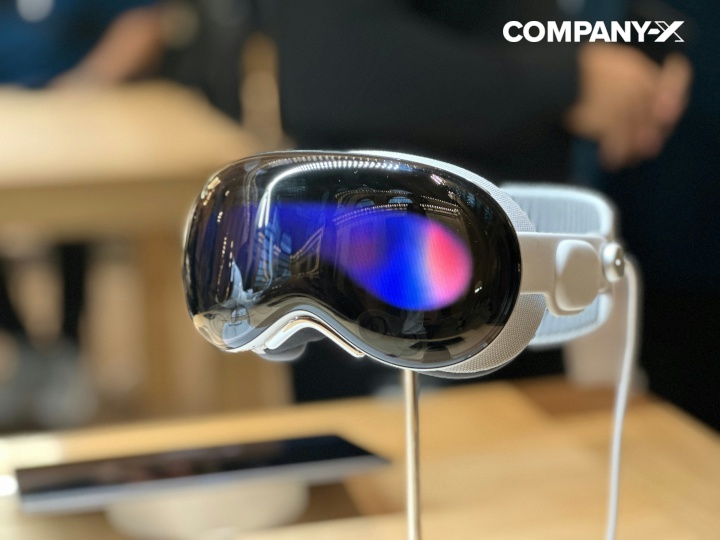Spatial Computing...the New Frontier
By Chris Gardner
The release of Apple’s new Vision Pro mixed-reality headset is creating innovative opportunities in multiple sectors on the new frontier of spatial computing.

The notion of augmented reality was popularized in 1987 when Gene Roddenberry, creator of the Star Trek series, introduced the Holodeck as a central component of The Next Generation. It created a new frontier of imagination. “Trekkies” were suddenly able to imagine a world where every location, interaction, and experience could be simulated in a way that felt real. In the 37 years since that debut, with the right tech, people can now visit Disneyland and interact directly with an animated Mickey Mouse or beam up to the bridge of the Starship Enterprise and take the captain’s chair to explore the final frontier with Mr. Spock and Mr. Data at their side. And while images of people walking around the streets of New York city with a 23-million-pixel spatial computing headset doesn’t equate to the holodeck experience, it does normalize the possibilities of simulated experiences for Trekkies, tekkies, and technophobes across industries including agriculture, manufacturing, and defence.
Spatial computing in agriculture
For Waikato farmers, the combination of spatial computing capabilities and the right software can yield tremendous results for their crops and planning. Farmers can use devices like the Apple Vision Pro for real time monitoring of crops at a micro level, collecting growth rate, plant health, and yield data from a variety of data sources thereby enabling them to create a three-dimensional virtual digital twin model of their fields and crops. Spatial computing technology can help farmers make data driven decisions by running simulations on different levels of farm inputs such as feed, fertiliser, and water. This approach reduces costs and drives a more sustainable approach to farming.
Spatial computing in manufacturing
Manufacturers can use devices like the Apple Vision Pro at all levels of the manufacturing process from complicated assembly to health and safety training. New employees can participate in virtual or augmented reality onboarding and training of complicated or dangerous processes, practicing again and again in the simulated environment at only the cost of the time taken. Product design can be taken to a whole new level; rendering an interactive conceptual product before any time and money is spent on physical development. Maintenance and repair are made easier with digital information overlays that are capable of walking the technician through the repair process in steps. Technicians can use FaceTime to call for expert support, using a digital avatar Apple refers to as a persona.
Spatial computing in defence
Apple Vision Pro is perfect for lucrative military contracts, posited Forbes senior contributor John Koetsier. Air Forces around the globe are a massive market for the high-end headset on account of the thousands of dollars per hour running cost of dome-type pilot training simulators. An appropriately Company-X developed Apple Vision Pro app would shrink the training costs to hundreds of dollars per hour. It could also be used to simulate military exercises with thousands of headset-equipped combatants. All without the costs associated with climbing into a real cockpit.
Spatial Computing in healthcare
The healthcare sector has wasted no time in putting Apple’s latest flagship device to use, improving medical training opportunities through sophisticated simulation solutions, and assisting medical professionals in their work. It has already been transformative.
- Thirty Apple Vision Pros have been deployed at Sharp Healthcare in San Deigo, USA, to monitor patients on wards and provide vital data during surgery.
- Dr Robert Masson of the Masson Spine Institute in Orlando and Park City, USA, has already used an Apple Vision Pro to guide him during spinal surgery.
- Radiologists are using the Apple Vision Pro to view high resolution radiology images.
- Medical students are using Apple Visio Pro to learn about the heart through 3D models, images, and simulations before treating patients in the real world.
Company-X has extensive experience in spatial computing, including augmented and virtual reality.
Interested in learning more about spatial computing and augmented reality? Visit the Company-X website at www.companyx.com or contact Chris Gardner via email at chris.gardner@companyx.nz or via phone at 027 231 7007.
About Company-X
Data is the leading global currency and leadership belongs to those that can unlock the greatest value from it. At Company-X, we exist to empower those visionary leaders who want to run the world better. We create the software that enables change through data-driven insights and automation. For defence, manufacturing contractors, infrastructure asset managers, and CTOs, we integrate complex systems, advance safety through simulation training, and enhance efficiency with AI. Our exclusively senior level expertise works alongside your teams to code and design your next great innovation. But we don’t just deliver software. We forge paths to digital transformation and operational efficiencies that run the world better.


 NZ Trucking Association: TruckSafe New Zealand Launches | A Game-Changer For Heavy Vehicle Safety And Compliance
NZ Trucking Association: TruckSafe New Zealand Launches | A Game-Changer For Heavy Vehicle Safety And Compliance Gaurav Mittal, IMI: How Can We Balance AI’s Potential And Ethical Challenges?
Gaurav Mittal, IMI: How Can We Balance AI’s Potential And Ethical Challenges? Science Media Centre: Several US-based Environmental Science Databases To Be Taken Down – Expert Reaction
Science Media Centre: Several US-based Environmental Science Databases To Be Taken Down – Expert Reaction Consumer NZ: Despite Low Confidence In Government Efforts, People Want Urgent Action To Lower Grocery Bills
Consumer NZ: Despite Low Confidence In Government Efforts, People Want Urgent Action To Lower Grocery Bills NZ Banking Association: Banks Step Up Customer Scam Protections And Compensation
NZ Banking Association: Banks Step Up Customer Scam Protections And Compensation The Reserve Bank of New Zealand: CoFR Seeking Feedback On Access To Basic Transaction Accounts
The Reserve Bank of New Zealand: CoFR Seeking Feedback On Access To Basic Transaction Accounts



